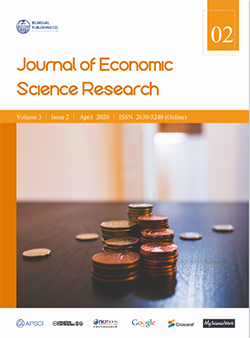Construction of Regional Economic Vitality Model
DOI:
https://doi.org/10.30564/jesr.v3i2.1655Abstract
Regional economic vitality reflects the scale and development potential of a region’s economy. It largely determines the development of the city, and is also affected by many factors such as population competitiveness, corporate competitiveness, market vitality, innovation vitality, and environmental vitality. A pilot model was constructed with Hebei Province as the inspection area. Quantitative measurement of regional economic vitality was made by finding 21 indicators that indirectly or indirectly affect the economic vitality of Hebei Province. By analyzing the data of 21 indicators for nearly 10 years, the time series clustering is used to achieve the dimensionality reduction of the indicators. After the dimension reduction, it is divided into four categories: overall scale, development potential, market vitality, and innovation vitality. Construct the economic vitality structure model of Hebei Province, and determine the four types of contribution to economic vitality and compare them. On this basis, more accurately grasp the indicators that affect economic vitality and work out reasonable and effective action plans. From the perspective of human resources and corporate vitality, analyze how the action plan accurately affects the economic vitality of Hebei Province[1]. The 11 cities in Hebei Province are the target of regional economic vitality. The economic vitality structure model constructed uses the required contribution value to select priority indicators. Finally, the six indicators of GPD, GPD growth rate, fiscal revenue, fiscal revenue growth rate, number of industrial enterprises above designated size, and total profit of industrial enterprises above designated size were established for eleven cities in Hebei Province to construct a TOPSIS scoring model, and calculation rankings were conducted through MATLAB. Results The top three cities were Shijiazhuang, Tangshan and Cangzhou.
Keywords:
Economic vitality structure model, Time series clustering, TOPSISReferences
[1] Huixia Jin, Yunqin Mao. The new normal of economic growth and supply-side structural reforms[J]. Taxation, 2019, 13 (04): 2019-220.
[2] Yejun Wang, Jingkui Zhou. The Impact of Entrepreneurial Vitality on Urban Industrial Economic Growth: An Empirical Study Based on Multidimensional Perspectives[J]. Scientific Decision, 2019 (01): 25-46.
[3] Na Wang. Analysis and Evaluation of Urban Vitality in Jiangxi Province[J]. Time-honored Brand Marketing, 2019 (03): 17-18.
[4] Mengqi Zhang. Analysis and Evaluation of Urban Vitality [D]. Wuhan University, 2018.
[5] Fei Wang, Wang Gui. Innovation drive stimulates the vitality of county economy [J]. Contemporary County Economy, 2019 (08): 60-61.
[6] Ruqun He. Research on Evaluation of Urban Economic Vitality in Pearl River-Xijiang Economic Belt [D]. Guangxi Normal University, 2019.
Downloads
Issue
Article Type
License
Copyright and Licensing
The authors shall retain the copyright of their work but allow the Publisher to publish, copy, distribute, and convey the work.
Journal of Economic Science Research publishes accepted manuscripts under Creative Commons Attribution-NonCommercial 4.0 International License (CC BY-NC 4.0). Authors who submit their papers for publication by Journal of Economic Science Research agree to have the CC BY-NC 4.0 license applied to their work, and that anyone is allowed to reuse the article or part of it free of charge for non-commercial use. As long as you follow the license terms and original source is properly cited, anyone may copy, redistribute the material in any medium or format, remix, transform, and build upon the material.
License Policy for Reuse of Third-Party Materials
If a manuscript submitted to the journal contains the materials which are held in copyright by a third-party, authors are responsible for obtaining permissions from the copyright holder to reuse or republish any previously published figures, illustrations, charts, tables, photographs, and text excerpts, etc. When submitting a manuscript, official written proof of permission must be provided and clearly stated in the cover letter.
The editorial office of the journal has the right to reject/retract articles that reuse third-party materials without permission.
Journal Policies on Data Sharing
We encourage authors to share articles published in our journal to other data platforms, but only if it is noted that it has been published in this journal.




 Dan Zhao
Dan Zhao

